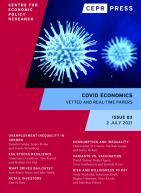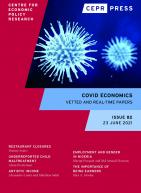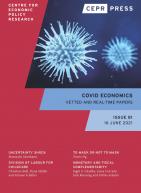
We document that racial disparities in COVID-19 in New York City stem from patterns of commuting and housing crowding. During the initial wave of the pandemic, out-of-home activity related to commuting is strongly associated with COVID-19 cases at the ZIP Code level and hospitalization at an individual level. After layoffs of essential workers decreased commuting, case growth continued through household crowding. A larger share of individuals in crowded housing or commuting to essential work are Black, Hispanic, and lower-income. As a result, structural inequalities, rather than population density, help determine the cross-section of COVID-19 risk exposure in urban areas.
Citation
Orane-Hutchinson, A, J Coven, A Gupta and M Almagro (2020), ‘Racial Disparities in Frontline Workers and Housing Crowding during COVID-19: Evidence from Geolocation Data‘, COVID Economics 51, CEPR Press, Paris & London. https://cepr.org/publications/covid-economics-issue-51#392514_392927_390638
The time-dependent reproduction number, Rt, is a key metric used by epidemiologists to assess the current state of an outbreak of an infectious disease. This quantity is usually estimated using time series observations on new cases, or deaths, combining this information with the distribution of the serial interval of transmissions. For a new epidemic, such as COVID-19, the available information on the serial interval is limited. Bayesian methods are often used to combine this limited information with the new cases, with the new cases usually being smoothed by a simple, but to some extent arbitrary, moving average. This paper describes a new class of time series models for tracking and forecasting new cases. The viability of these models and their ability to deal with spikes and second waves is illustrated with data from Germany and Florida. As a by-product, estimates of Rt, together with their standard deviations, can be obtained from the growth rate of new cases. Very few assumptions are needed and those that are made can be checked. This leads us to the conclusion that tracking an epidemic by trying to estimate Rt may be neither necessary nor desirable.
Citation
Kattuman, P and A Harvey (2020), ‘A Farewell to R: Time Series Models for Tracking and Forecasting Epidemics‘, COVID Economics 51, CEPR Press, Paris & London. https://cepr.org/publications/covid-economics-issue-51#392514_392927_390639
According to conventional wisdom, banks play a special role in providing liquidity in bad times, while capital markets are used to fund investment in good times. Using micro-data on corporate balance sheets following the COVID-19 shock, we provide evidence that instead, the corporate bond market is central to firms' access to liquidity, crowding out bank loans even when the banking sector is healthy. We first show that, contrary to good times, bond issuance is used to increase holdings of liquid assets rather than for real investment. Second, most issuers, including many riskier "high-yield" firms, prefer issuing bonds to borrowing from their bank. Over 40% of bond issuers leave their credit line untouched in 2020Q1. Moreover, a large share of bond issuance is used to repay existing bank loans. This liquidity-driven bond issuance questions the comparative advantage of banks in liquidity provision, and suggests that the V-shaped recovery of bond markets, propelled by the Federal Reserve, is unlikely to lead to a V-shaped recovery in real activity.
Citation
Siani, K and O Darmouni (2020), ‘Crowding Out Bank Loans: Liquidity Driven Bond Issuance‘, COVID Economics 51, CEPR Press, Paris & London. https://cepr.org/publications/covid-economics-issue-51#392514_392927_390640
On March 24, 2020, India's Prime Minister announced the world's largest COVID-19 lockdown, bringing to a near-halt the economic and social lives of more than one billion Indian residents. This paper quantifies the economic impacts and behavioral changes induced by this unprecedented policy using two unique data sources: Facebook mobility data and a representative sample of previously surveyed low income Delhi households. Compliance with the lockdown was widespread: intra-city movement declined by 80\% following the announcement. The economic consequences have been accordingly severe, with income and days worked falling by 86 and 72\% respectively. Nevertheless, observance of public health directives was high: mask usage rose by 73 percentage points and handwashing became nearly universal, while time spent outdoors and smoking both declined. We also show how government-provided social assistance may have averted more dire predictions of widespread famine, resource scarcity, access to medical care, and security. But the declines in mental health and the near-exhaustion of personal savings, amidst a rising infection rate, indicate an important and evolving role for policy-makers as the crisis continues.
Citation
Sahai, H, M Greenstone, K Lee and P Baylis (2020), ‘Job Loss and Behavioral Change: The Unprecedented Effects of the India Lockdown in Delhi‘, COVID Economics 51, CEPR Press, Paris & London. https://cepr.org/publications/covid-economics-issue-51#392514_392927_390641
The COVID-19 pandemic and the consequent Government-imposed restrictions have altered the way of life around the globe. Using the newly “Nigeria Baseline COVID-19 National Longitudinal Phone Survey 2020â€, this paper contributes to the nascent literature on the Economics of COVID-19 by examining the impact of changes in income and social assistance due to the pandemic on the coping strategies of family business owners. We find that family business owners who experienced a reduction in income and those that received social assistance due to the pandemic are likely to increase their coping level. We discuss the policy implications of these findings.
Citation
Ndubuisi, G and E Avenyo (2020), ‘Coping During COVID-19: Family Businesses and Social Assistance in Nigeria‘, COVID Economics 51, CEPR Press, Paris & London. https://cepr.org/publications/covid-economics-issue-51#392514_392927_390642


Covid Economics - Issue 82
- Restaurant Closures during the Pandemic: A Descriptive Analysis
- Underreporting Child Maltreatment during the Pandemic: Evidence from Colorado
- Covid-19 impact on Artistic Income
- COVID-19, Employment, and Gender: Evidence from Nigeria
- The Importance of Being Earners: Modelling the Implications of Changes to Welfare Contributions on Macroeconomic Recovery
